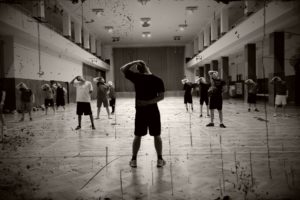SCIENCE BEHIND WARM UP
I see many aspiring fitness athletes, who directly jump on to workout or training session without a basic warm-up. Unaware about the science behind the warm-up many people tend to ignore it, due to which they face injuries and get less benefit from workout session.
So let’s unfold the science behind the warm-up.

What is warm-up?
Warm-up is the initial process of making yourself ready mentally and physically for the upcoming workout or training or competition.
Consider your body as a machine or an engine, for any engine to get started it needs to reach a temperature high enough to allow it to run efficiently. Likewise, our body also doesn’t perform efficiently if its temperature not high enough.
Therefore, a well designed warm-up routine will help in raising your body temperature high enough to perform efficiently and bring many other positive impacts on your performance during workout/training.
There are four main types of stretching: static, dynamic, ballistic and proprioceptive neuromuscular facilitation (PNF).
Warm-up Mechanize
A proper warm-up will activate your stretch reflex or in laymen terms muscle contraction and relaxation.
Stretch Reflex
This can be best explained with Knee-jerk reflex, also called patellar reflex, when the doctor taps on the patellar tendon a sudden kicking movement is generated of the lower leg.
When tapped on the patellar tendon in the knee, the muscle spindles in the muscles convey information to your spinal cord to lengthen the muscles. In reaction to that, the spinal cord sends response impulse for the muscles to shorten. Which is a very quick impulse occurs within 1-2 milliseconds.
This is also a phenomenon of muscles protecting it from being pulled too far and tearing, which helps in preventing injuries.
Every time before exercise our stretch reflex is in off mode or compressed state. A basic warm-up will inform your muscles to get activated and make it ready for the lengthening and shortening for the upcoming training session.
Mistake to avoid
Many people tend to perform static stretching as a warm-up routine that needs to be avoided. However, it should be performed as a cool-down routine.
Consider your muscles as a rudder band. When pulled and released, it comes back with force. Similarly, when pulled above its tolerance either rudder band breaks or gets overstretched losing its tolerance. Muscles also behave similarly, performing static stretching will make your muscles to reach its tolerance limit and immediately proceeding to workout may cause muscles to lose its tolerance which will lead to low performance and injury.
Instead of static stretching, it is suggested to perform a dynamic functional warm-up before the workout.
Benefits of performing a dynamic functional warm-up before workout:
- Muscles get activated to its working temperature.
- Gets you prepared for a high-intensity workout.
- Muscle contraction and relaxation increase.
- Better reaction time or reflexes.
- Increased muscle strength.
- Better blood flow.
- Reduces the chance of injury.
- Psychologically prepared.
- Better metabolic rate.
- A decrease in viscosity.
How warm-up helps you?
A good warm-up helps you in two ways:
Temperature and non-temperature related benefits.
Temperature related benefits:
- The entire core body and muscle temperature increases.
- Muscles neuronal function improves which helps in better performance.
Non-temperature-related benefits:
- Increase in blood flow.
- Increase in oxygen consumption.
- Increase in metabolic rate resulting in more effect on muscles while workout.
- An increase in post excitation potential of muscle fibers results in better performance in workout potential.
How to do warm-up:
Warm-up has to be performed in three phases:
Phase I: In which we will perform a dynamic functional warm-up routine. Duration (10 – 20mins)
Phase II (Rehearsal phase): Rehearsal varies depending on the workout or training or competition.
In case of workout, we will rehearsal our workout with lightweights.
Suppose you’re working on the legs, begin with a light weighted rehearsal (2sets X 15 reps) and then eventually increase weight based on your preference.
In case if you’re training for a specific sport then rehearsal based on the nature of game.
Suppose you training for soccer, rehearsal on your kicks before the game.
Note: Begin phase II within 15mins upon completion of phase I.
Phase III: Cool down static stretching, this comes at the end after completing your entire workout or competition.
Similar to phase II, Cool down static stretching also should be performed based on the workout of the day.
Suppose you have worked on legs, include static stretching for your legs and every stretch should be held usually somewhere between 10 to 30 seconds.
Hoping every aspiring fitness athlete to include warm-up in their routine.




